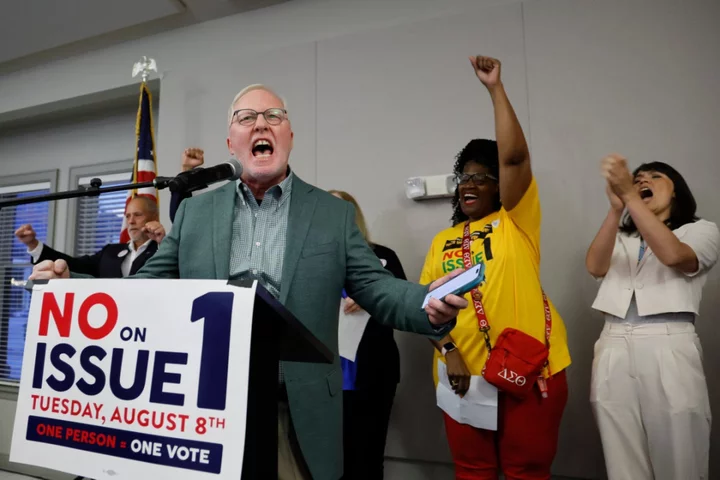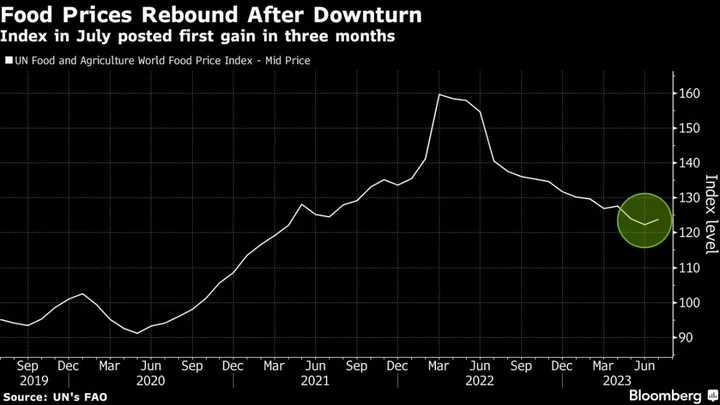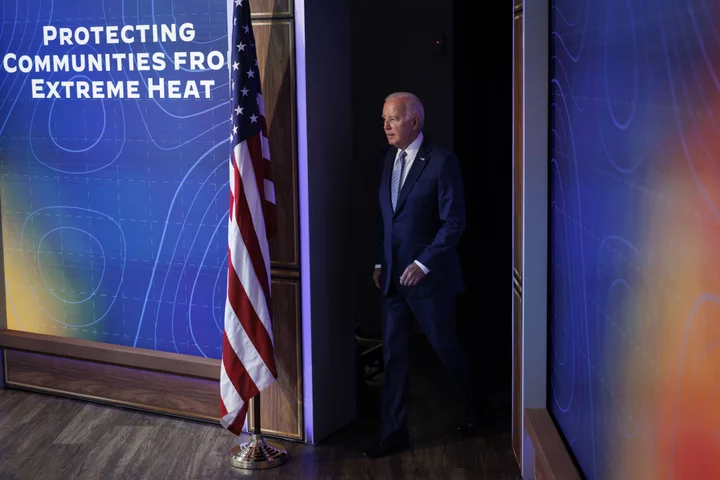
Postal Center International (PCI) empowers students for the new school year
WESTON, Fla.--(BUSINESS WIRE)--Aug 9, 2023--
2023-08-10 01:16

Affordable EVs: 10 Electric Cars You Can Get for Under $40,000
Like most emerging technologies, electric vehicles hit the market with high price tags, and were
2023-08-10 00:19

Sixto Rodriguez, subject of Oscar-winning doc 'Searching for Sugar Man,' dead at 81
Detroit musician Sixto Rodriguez, the subject of the documentary "'Searching for Sugar Man" -- which won the 2013 best documentary Academy Award -- has died, according to an announcement on his official website.
2023-08-09 23:57

Rome archaeologist says Travis Scott's Circus Maximus concert risked damaging ancient site
The director of Rome's Colosseum has called for an end to concerts at the nearby Circus Maximus, after a performance by US rapper Travis Scott on Monday sparked fears of an earthquake.
2023-08-09 23:53

Ohio vote shows enduring power of abortion rights at ballot box, giving Democrats a path in 2024
Abortion wasn't technically on the ballot in Ohio's special election. But the overwhelming defeat of a measure that would have made it tougher to enshrine abortion rights in the state constitution this fall was the latest indicator that the issue remains a powerful force at the ballot box. The election saw heavy turnout for what's typically a sleepy summer election date and sets up another battle in November, when Ohio will be the only state this year to have reproductive rights on the ballot. It also gives hope to Democrats and other abortion rights supporters who say the matter could sway voters their way again in 2024. That's when it could affect races for president, Congress and statewide offices, and when places such as the battleground of Arizona may put abortion questions on their ballots as well. Democrats described the victory in Ohio, a one-time battleground state that has shifted markedly to the right, as a “major warning sign” for the GOP. “Republicans’ deeply unpopular war on women’s rights will cost them district after district, and we will remind voters of their toxic anti-abortion agenda every day until November,” said Aidan Johnson, a spokesperson for the Democratic Congressional Campaign Committee. The measure voters rejected Tuesday, known as Issue 1, would have required ballot questions to pass with 60% of the vote rather than a simple majority. Interest was unusually high, with millions spent on each side and voters casting more than double the number of early in-person and mail ballots ahead of the final day of voting as in a typical primary election. Early turnout was especially heavy in the Democratic-leaning counties surrounding Cleveland, Columbus and Cincinnati. Opposition to the measure, which became a kind of proxy for the November abortion vote, extended even into traditionally Republican areas. In early returns, support for the measure fell far short of Donald Trump’s performance during the 2020 election in nearly every county. The November ballot question will ask voters whether individuals should have the right to make their own reproductive health care decisions, including contraception, abortion, fertility treatment and miscarriage care. Ohio's GOP-led state government in 2019 approved a ban on abortion after cardiac activity is detected — around six weeks, before many women know they are pregnant — but the ban was not enforced because of the U.S. Supreme Court ruling in Roe v. Wade, which granted a federal right to the procedure. When a new conservative majority on the high court last year overturned the nearly 50-year-old ruling, sending authority over the procedure back to the states, Ohio's ban briefly went into effect. But a state court put the ban on hold again while a challenge alleging it violates the state constitution plays out. During the time the ban was in place, an Indiana doctor came forward to say she had performed an abortion on a 10-year-old rape victim from Ohio who could not legally have the procedure in her home state. The account became a national flashpoint in the debate over abortion rights and underscored the stakes in Ohio. Ohio is one of about half of U.S. states where citizens may bypass the Legislature and put ballot questions directly to voters, making it an option that supporters of reproductive rights have increasingly turned to since Roe v. Wade fell. After abortion rights supporters said they hoped to ask voters in November to enshrine the right in the state constitution, Ohio Republicans put Issue 1 on Tuesday’s ballot. In addition to raising the threshold to pass a measure, it would have required signatures to be collected in all 88 counties, rather than 44. The 60% threshold was no accident, abortion rights supporters say, and was aimed directly at defeating the Ohio abortion measure. Since Roe v. Wade was overturned, six states have had elections regarding reproductive rights. In every election — including in conservative states like Kansas — voters have supported abortion rights. In Kansas, 59% voted to preserve abortion rights protections, while in Michigan 57% favored an amendment that put protections in the state constitution. Last year, 59% of Ohio voters said abortion should generally be legal, according to AP VoteCast, a broad survey of the electorate. Last month, a poll by the Associated Press-NORC Center for Public Affairs Research found the majority of U.S. adults want abortion to be legal at least through the initial stages of pregnancy. The poll found that opinions on abortion remain complex, with most people believing abortion should be allowed in some circumstances and not in others. Opponents of the Ohio abortion question ran ads that suggested the measure could strip parents of their ability to make decisions about their child’s health care or to even be notified about it. Amy Natoce, spokesperson for the anti-abortion campaign Protect Women Ohio, called the ballot measure a “dangerous anti-parent amendment.” Several legal experts have said there is no language in the amendment supporting the ads’ claims. Peter Range, CEO of Ohio Right to Life, said he has been traveling across Ohio talking to people and “I’ve never seen the grassroots from the pro-life side more fired up to go and defend and protect the pre-born.” While the November question pertains strictly to Ohio, access to abortion there is pivotal to access across the Midwest, said Alison Dreith, director of strategic partnership for the abortion fund Midwest Access Coalition. Nine Midwestern states — Indiana, Iowa, Kansas, Ohio, Nebraska, Missouri, North Dakota, South Dakota and Wisconsin — are considered restrictive, very restrictive or most restrictive of abortion rights by the Guttmacher Institute, a research and policy organization that supports legal access to abortion. “Ohio in particular has always been a destination state for the states around it,” Dreith said. “If we don’t protect abortion access in Ohio, the options just continue to shrink for people seeking care in the Midwest.” Sri Thakkilapati, the executive director of the Cleveland-based nonprofit abortion clinic Preterm, said the effect of the Ohio vote will reverberate throughout the country. “When we restrict access in one state, other states have to take up that patient load,” she said. “That leads to longer wait times, more travel, higher costs for patients." Thakkilapati called the energy around abortion rights in last year's midterms “exciting.” But she said the media attention died down, and people quickly forgot “how tenuous abortion access is right now.” The special election and ballot measure in Ohio are “a reminder of what’s at stake," Thakkilapati said. “Other states are watching how this plays out in Ohio, and it may give anti-abortion groups in other states another strategy to threaten abortion rights elsewhere,” she said. “And for the majority who do want abortion access in their states but are seeing it threatened, the results in November could give them hope that the democratic process may give them relief.” Kimberly Inez McGuire, the executive director of Unite for Reproductive and Gender Equity, which focuses on young people of color under age 30, says the results of elections involving reproductive rights show that support doesn't come just from Democrats or in cities and states considered liberal bastions. “There was this idea that we couldn’t win on abortion in red states and that idea has really been smashed,” McGuire said. So, too, she said, is the “mythology” that people in the South and Midwest won't support abortion rights. “I think 2024 is going to be huge,” she said. “And I think in many ways, Ohio is a proving ground, an early fight in the lead up to 2024.” Dreith said that since abortion hasn't been on a major ballot since last year, the Ohio vote this fall is “a good reminder” for the rest of the country. “Abortion is always on the ballot — if not literally but figuratively through the politicians we elect to serve us,” she said. "It’s also a reminder that this issue isn’t going away.” Read More Ukraine war’s heaviest fight rages in east - follow live Charity boss speaks out over ‘traumatic’ encounter with royal aide Why Ohio's Issue 1 proposal failed, and how the AP called the race Ohio voters reject GOP plan to thwart upcoming abortion rights proposal Abortion rights advocates push for 2024 ballot initiative in Arizona
2023-08-09 23:50

World’s Top Food Producers Push Back on EU Deforestation Rules
The world’s largest agriculture producers are pushing back against new European Union rules that require proof that crops
2023-08-09 23:17

Rising prices for travel yet to curb wanderlust
By Joanna Plucinska, Rajesh Kumar Singh, Doyinsola Oladipo and Priyamvada C LONDON/CHICAGO/NEW YORK (Reuters) -The post-pandemic travel boom and the
2023-08-09 22:51

What is TikTok’s ‘soft life era’ and could it be the secret to happiness?
The term ‘soft life’ is trending on TikTok, with the #softlifeera tag clocking 12.2million views. While not brand new, it seems a growing number of social media users are leaning towards the lifestyle concept – but what does soft life actually mean and how can it benefit people? Where does the trend come from? As the wording suggests, soft life is all about veering away from stress and struggle and embracing a more easy and enriched life. But this isn’t just about life looking ‘perfect’ on social media. “Soft life isn’t new, however I’m really grateful to see its resurgence,” said Chlöe Pierre, founder of wellness platform thy.self and author of Take Care: The Black Women’s Guide To Wellness. “Essentially to me, especially as a black woman, soft life is about making choices that can avoid me having to live a much longer, and unsustainable, life in hardship. For me it’s about wellness in general, and sustainable wellness. “My only concern when seeing trends [on social media] is that they are inclusive, and generally they aren’t. First and foremost, soft life is a choice – and it’s a privilege to be able to make that choice,” Pierre added. “Originally, the soft life kind of movement had origins in places like Nigeria and other places around the continent, but was popularised via America and a lot of African American women, [who were often] fictional characters on TV. Because there weren’t, especially not in the UK, reachable or visible representations of black women and women of colour that had amassed a wealth, and therefore the privilege of living a ‘soft life’.”Permission to live a soft life For Dr Evelyn Okpanachi, author of The Emotionally Empowered Woman, it makes sense people are increasingly leaning towards the trend. “Collectively, we are still tired. We have had the Covid era, austerity and more, and we simply want to live and breathe a little. This is why we are leaning towards it more right now. Collectively, we are breathing a sigh of relief,” said Okpanachi. “Most people associate the soft life with booking last-minute flights, mojitos on the beach, dining at nice restaurants and all of the externalities. It is in part, but it a lot deeper than that. “Soft life is living life on your terms. Creating a career you want, the business you want, and looking after yourself holistically. This starts with empowering yourself to succeed by elevating your mindset and knowing you deserve to live a soft life.” Nothing comes easy Okpanachi noted the work that can be involved, however. “In order to enter the soft life era, the average person tends to go through an element of stress. Nothing comes easy,” she explained. “It is essentially about purposely creating a lifestyle with minimal stress and setting boundaries – boundary setting is key. It’s embracing the things that serve you and letting go/eliminating the things that don’t. We all deserve to live a soft life, and we all should. But we have to put the work in to attain it.” This is something social media can often miss out. As Pierre noted, influencers or celebrities may “show you one side of their life – you don’t get to see the struggle they have had to get to that point, or to maintain that lifestyle they have in front of the camera”. Making space for a softer lifeFor many, the dilemma is making these things a reality when work takes up so much energy, along with caring/parenting duties, health challenges and everything else. Pierre discusses in her book about how our identities can be “very wrapped up” in work, which can make it so much more draining – especially for black women who have faced “more hardship in the workplace, compared to other demographics”. Setting “clear expectations and intentions” for yourself can be helpful, she added, and getting to know yourself better. “So making clear expectations about who I am, what I will accept, and what I want – and having the belief that I don’t have to go through too much hardship, that it’s not a benchmark for who I am,” Pierre explained. “This can even be applied to dating.” Ditch the guilt Donna Noble, yoga teacher and author of Teaching Body Positive Yoga: A Guide To Inclusivity, Language And Props, also believes making things intentional is key for how people can embrace the soft life in their everyday routines. “[People] can prioritise their me-time and be intentional about it – for instance, meditating, journaling or doing yoga as soon as they get up (before the rest of the world invades their space), as this will set you up nicely for the rest of the day,” said Noble. “I believe rest and self-care are part of our birth-right – no feeling guilty for just being and not doing. Normalise taking the pause, and that it can be the most powerful thing we do in our day.” For those who struggle to put themselves first, Noble suggested taking time to work on giving yourself permission. “The key here is a shift in perspective and empowerment – you’ve got to discover the precious gem that is your wellbeing. Society’s old scripts may try to hold us back, but rewriting the narrative is where the magic happens,” she said. “Giving ourselves a permission slip to prioritise self-care isn’t just a luxury; it’s a necessity. It’s about understanding that nurturing ourselves isn’t selfish; it’s the foundation for health and wellbeing.” Read More Charity boss speaks out over ‘traumatic’ encounter with royal aide Ukraine war’s heaviest fight rages in east - follow live Kim Kardashian teased as the face of a major fashion brand Shoppers make seven big impulse buys per year on average – survey Even 4,000 steps a day could ‘reduce risk of death’ – study
2023-08-09 22:26

Biden Decries Climate Threat But Does Not Declare Emergency
President Joe Biden stopped short of saying he would declare a national climate emergency, a move progressive lawmakers
2023-08-09 22:19

Carmakers Are Playing Catch-Up With Tesla on Air Filtration
The checklist for a safe car trip in the era of climate change goes a little something like
2023-08-09 21:51

Totino's™ Gets Zesty with New Fan-Favorite Pizza Roll Flavor – Orange Chicken
MINNEAPOLIS--(BUSINESS WIRE)--Aug 9, 2023--
2023-08-09 21:29

Febreze Introduces the NEW Mood Collection, Designed to Help Consumers Set Moods at Home
CINCINNATI--(BUSINESS WIRE)--Aug 9, 2023--
2023-08-09 21:26
